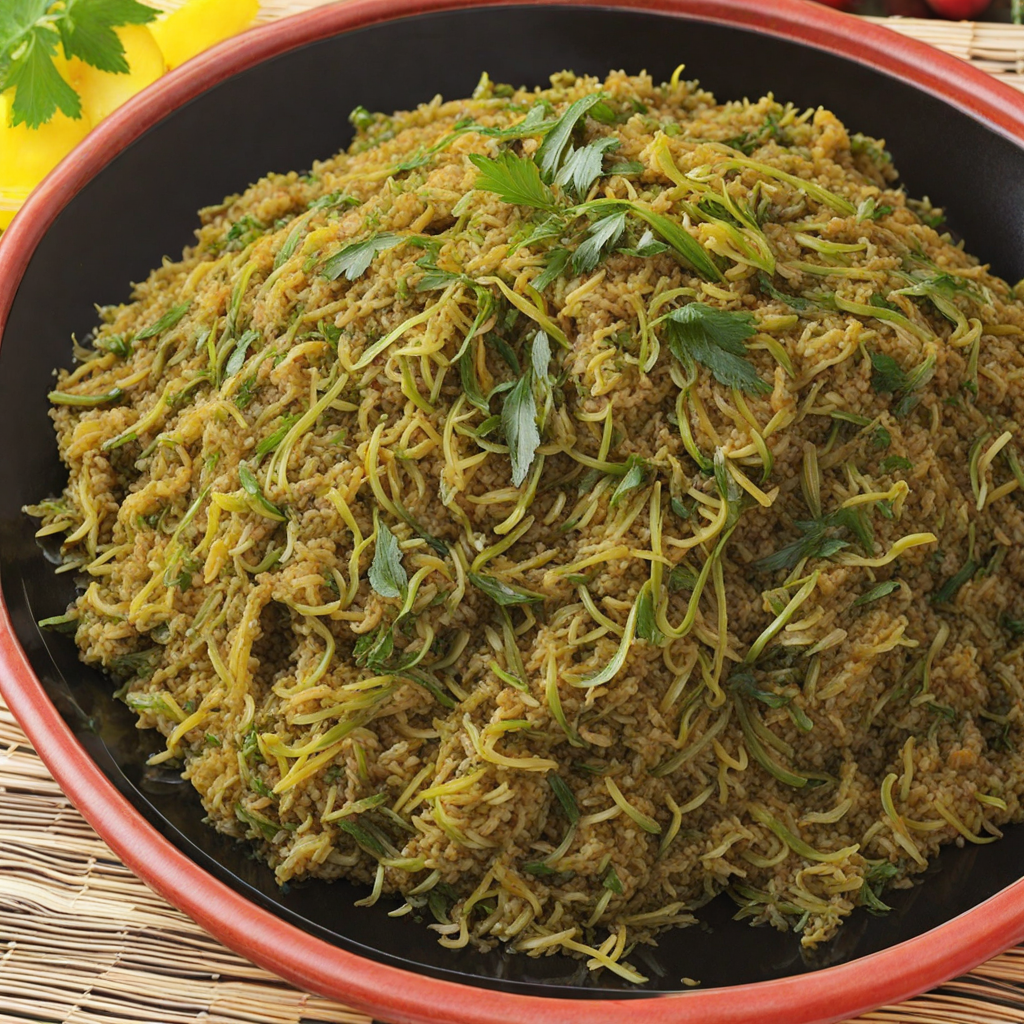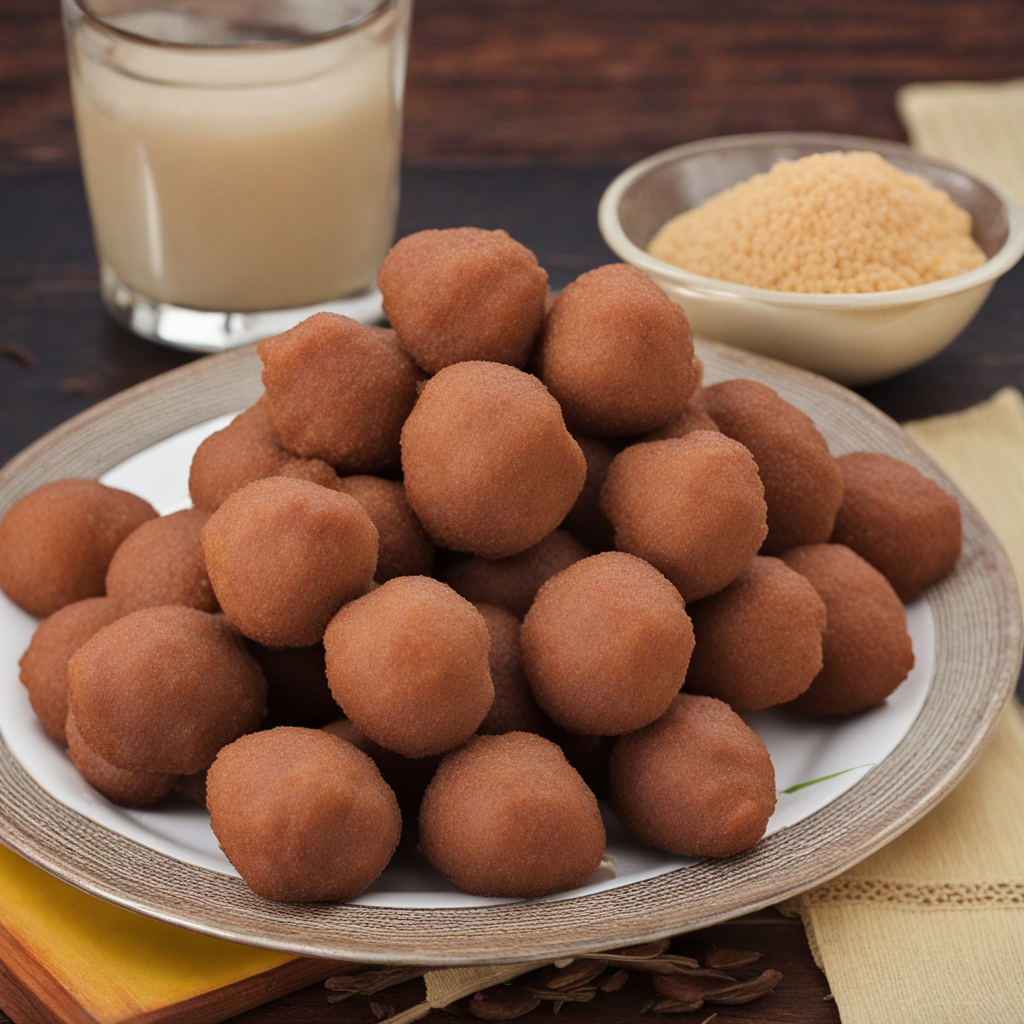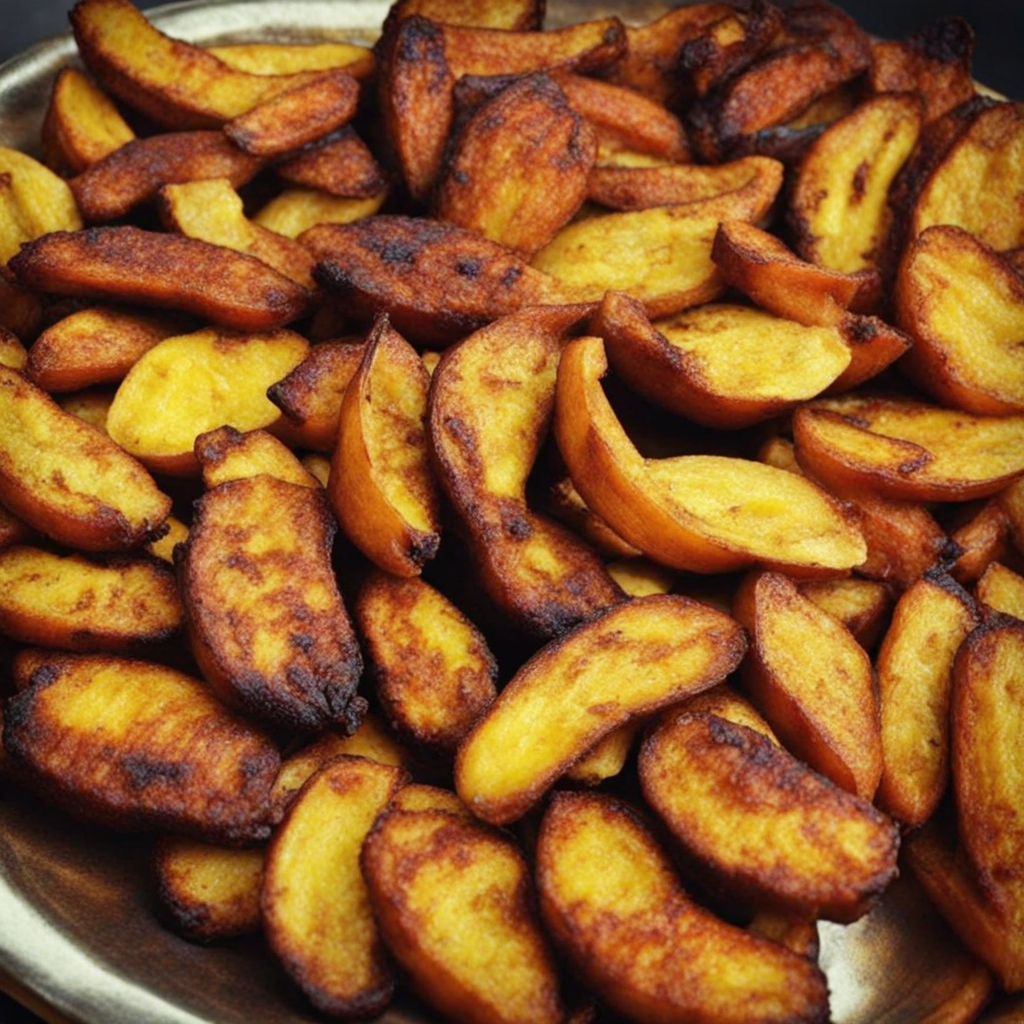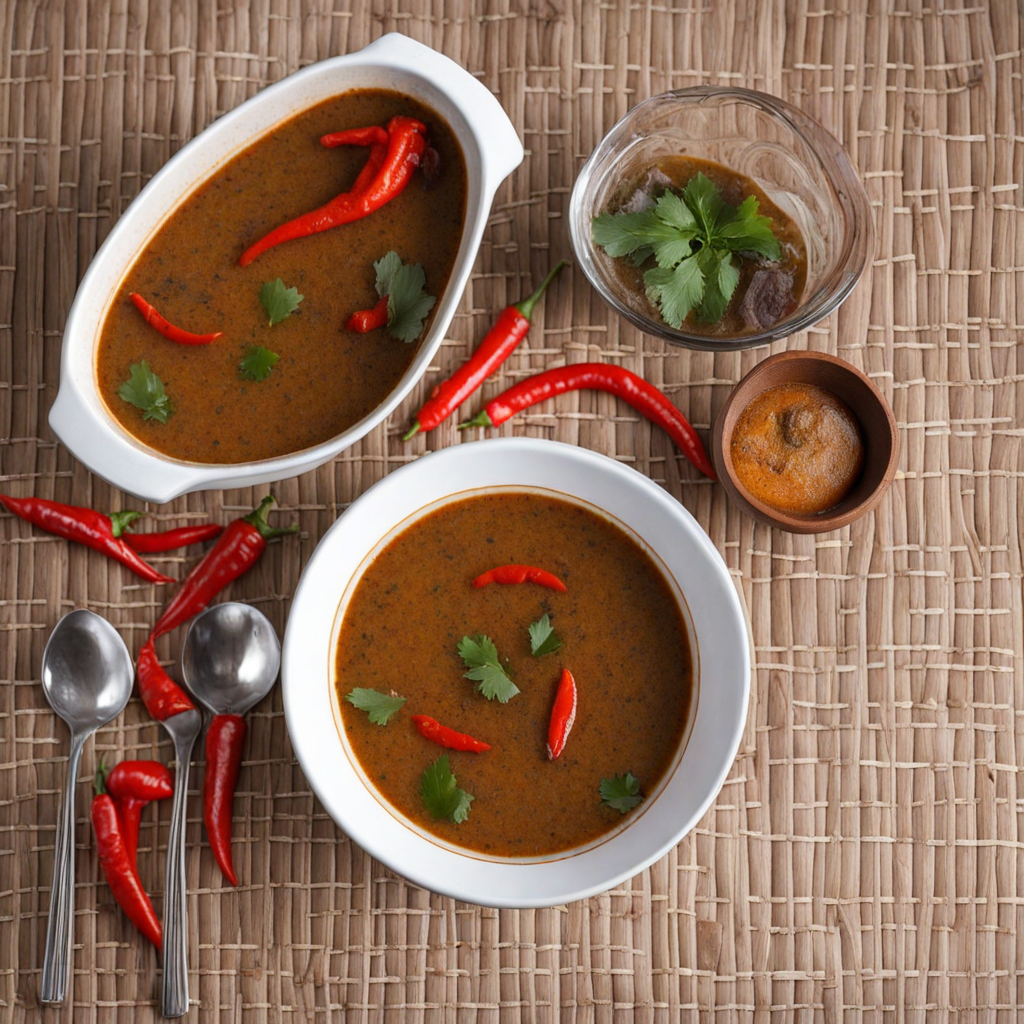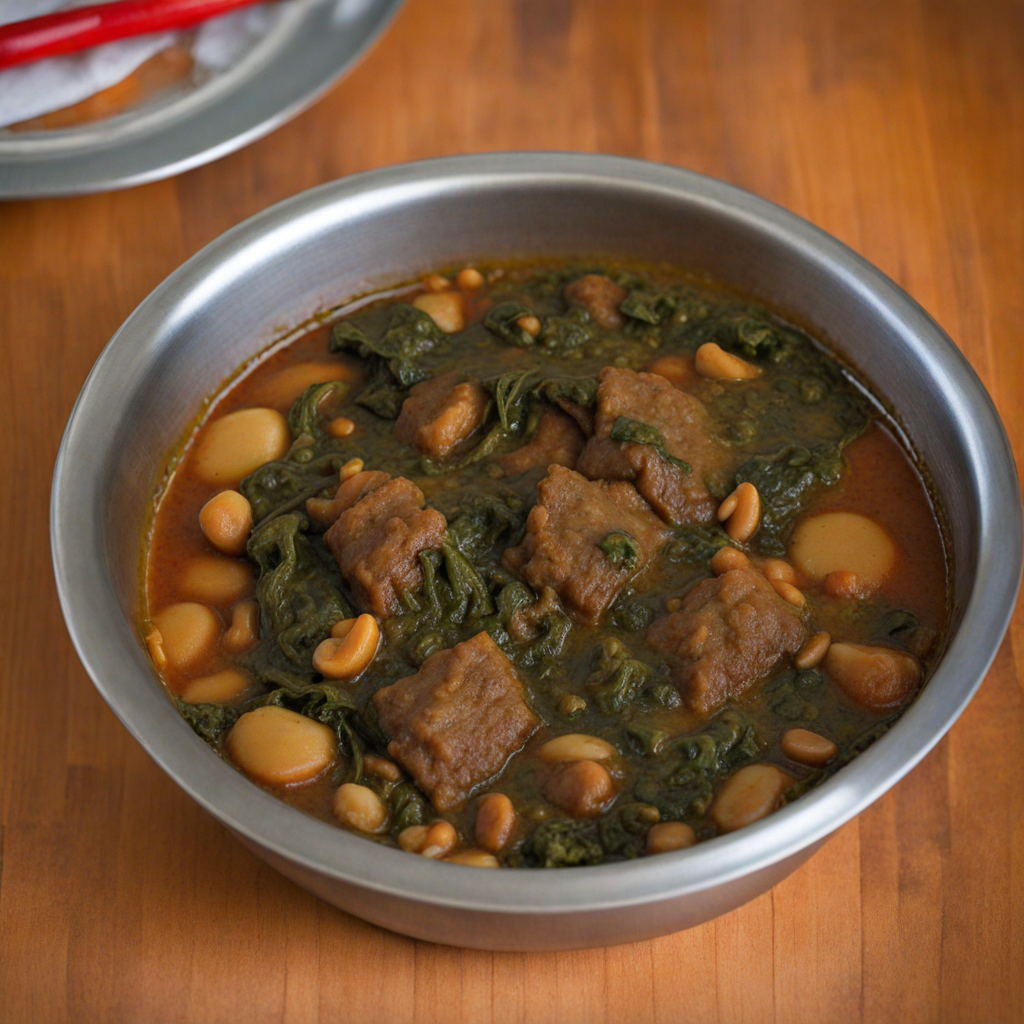Eru
Eru is a traditional Cameroonian dish that tantalizes the taste buds with its rich and earthy flavors. This dish is primarily made from the leaves of the Gnetum plant, commonly known as Eru leaves, which are finely chopped and simmered to create a vibrant green base. The leaves impart a slightly bitter yet savory taste, which is beautifully balanced by the addition of ground crayfish and spices. The texture is both tender and slightly fibrous, giving it a unique mouthfeel that sets it apart from other leafy dishes. Eru is often cooked with palm oil, which adds a luscious richness and a deep, warm color to the dish, making it visually appealing as well as delicious. To enhance its flavor profile, Eru is frequently combined with various proteins, such as beef, chicken, or fish, allowing the dish to cater to different palates. The proteins are typically cooked until tender, soaking up the aromatic essence of the Eru leaves and the spices. The dish is often seasoned with traditional spices like pepper and ground seeds, creating a fragrant harmony that lifts the dish to new culinary heights. The combination of the slightly bitter greens, the umami from the proteins, and the aromatic spices creates a complex and satisfying flavor that is both comforting and invigorating. Served alongside a staple carbohydrate like fufu, plantains, or rice, Eru makes for a hearty and wholesome meal that embodies the spirit of Cameroonian cuisine. This dish not only showcases the diverse ingredients of the region but also reflects the communal aspect of eating in Cameroon, where meals are often shared among family and friends. For those adventurous eaters looking to explore new flavors, Eru promises an authentic taste of Cameroon, rich in history and flavor, that is sure to delight and surprise.
How It Became This Dish
Eru, often referred to as "Eru soup" or "Eru leaves," is a cherished dish in Cameroon, particularly among the people of the Southwest and Littoral Regions. This flavorful and nutritious dish is made primarily from the leaves of the Gnetum africanum plant, commonly known as Eru or Afang in some regions. Its unique taste and cultural importance make it a noteworthy element of Cameroonian cuisine, reflecting the rich traditions and culinary practices of the nation. Origins of Eru The origins of Eru can be traced back to the indigenous communities of Cameroon, where Gnetum africanum has been used for centuries. This leafy vegetable thrives in the tropical climates of Central and West Africa, particularly in dense forests, making it readily available to local populations. While the exact timeline of its domestication is unclear, it is believed that the use of Eru dates back to pre-colonial times when forest resources were integral to the survival and sustenance of various ethnic groups. Gnetum africanum is not just a culinary ingredient; it also holds medicinal properties. Historically, the leaves have been used to treat ailments such as fever and digestive issues, showcasing the holistic approach to health and nutrition in traditional Cameroonian societies. As a wild-harvested food, Eru has played a role in the local economy, particularly for women who gather the leaves and sell them in markets, thus contributing to their households' income. Cultural Significance Eru is much more than a dish; it is a symbol of community, heritage, and identity for many Cameroonians. It is often prepared during significant celebrations, family gatherings, and communal meals, reinforcing social bonds and cultural practices. The preparation of Eru can be seen as a communal activity, where family members come together to process the leaves, cook, and share stories, creating a sense of belonging and continuity. In many ethnic groups, particularly among the Bantu-speaking peoples, Eru is associated with hospitality and generosity. Serving Eru soup to guests is a sign of respect and warmth, embodying the Cameroonian spirit of togetherness. It is often accompanied by other dishes such as plantains, fufu, or cassava, making it a centerpiece in traditional meals. Development Over Time Over the years, the preparation and consumption of Eru have evolved, influenced by various factors including globalization, urbanization, and dietary changes. Traditionally, Eru was prepared with minimal ingredients, highlighting the natural flavors of the leaves. However, modern adaptations have introduced a variety of ingredients, such as meats (often fish, beef, or chicken), palm oil, and spices, enhancing the dish's flavor and nutritional profile. In urban areas, where access to fresh produce may be limited, pre-packaged Eru or frozen versions of the leaves have gained popularity. This convenience has made Eru more accessible to a wider audience, allowing people to enjoy this traditional dish even without the time or resources to prepare it from scratch. The modernization of cooking techniques, such as the use of electric stoves and pressure cookers, has also influenced how Eru is cooked, making it quicker and easier to prepare. Despite these changes, the essence of Eru remains intact. Many families continue to honor traditional recipes passed down through generations, ensuring that the cultural significance of the dish endures. In this way, Eru serves as a bridge between the past and the present, connecting individuals to their heritage while adapting to contemporary lifestyles. Nutritional Value Eru is not only a culturally significant dish but also a highly nutritious one. The Gnetum africanum leaves are rich in vitamins A, C, and E, as well as essential minerals such as iron and calcium. The dish is also known for its high protein content, especially when prepared with various meats or fish. This nutritional profile makes Eru a vital component of the diet for many Cameroonians, especially in rural areas where access to diverse food sources may be limited. Challenges and Conservation The popularity of Eru has, however, led to some challenges. Overharvesting of Gnetum africanum in the wild has raised concerns about sustainability and the conservation of this vital resource. As urban demand for Eru grows, there is a risk of depleting local populations of the plant, threatening its availability for future generations. Efforts are being made to cultivate Gnetum africanum sustainably and promote agroforestry practices that allow for the continued harvesting of Eru while preserving the environment. Conclusion Eru is more than just a dish; it is a testament to the resilience and richness of Cameroonian culture. Its origins in indigenous practices, combined with its evolving nature in contemporary society, illustrate the dynamic interplay between tradition and modernity. As Cameroonians continue to gather around the table to enjoy Eru, they not only nourish their bodies but also celebrate their shared heritage and community. In a world that is increasingly fast-paced and globalized, Eru remains a cherished reminder of the importance of food in forging connections and preserving cultural identity. Through its history, preparation, and continued relevance, Eru stands as a proud emblem of Cameroonian culinary heritage.
You may like
Discover local flavors from Cameroon


